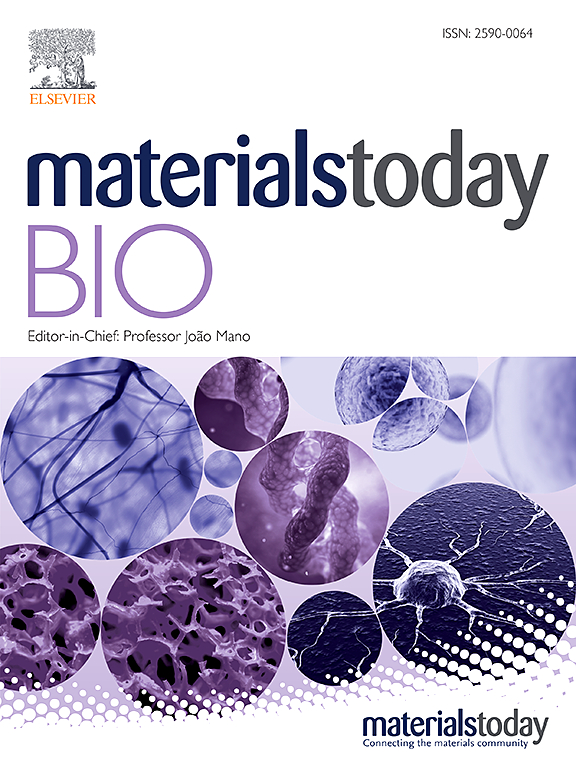碳纳米管/吡咯烷酮羧酸锌海绵用于糖尿病伤口的程序化管理:止血、抗菌、抗炎和愈合特性
IF 8.7
1区 医学
Q1 ENGINEERING, BIOMEDICAL
引用次数: 0
摘要
糖尿病患者的伤口愈合具有挑战性,因为慢性炎症,血管化不足,易感染。目前的伤口敷料通常针对特定的愈合阶段,缺乏全面的治疗方法。本研究介绍了一种利用含碳纳米管(CNTs)的光可拆卸海绵支架的新方法,碳纳米管以其高光热转换效率、导电性和吸水性能而闻名。该支架加入了吡咯烷酮羧酸锌(PC1Z2),这是一种具有抗炎和保湿特性的化合物,在碳纳米管网络和脱细胞真皮基质中交联。由此产生的形状记忆海绵支架与内源性电场积极结合,促进电信号传递到皮肤细胞,加速组织修复。在近红外(NIR)光照射下,PC1Z2支架通过光热转化,促进伤口部位的组织代谢,提高抗菌效果(98%)。值得注意的是,支架吸收伤口渗出液并逐渐释放Zn2+,有效减轻小鼠的慢性炎症。在糖尿病大鼠伤口模型中,PC1Z2支架吸收渗出液,减少炎症,加速肉芽组织形成,伤口血管生成和再上皮化。这种创新的PC1Z2海绵敷料有望促进糖尿病伤口的愈合。本文章由计算机程序翻译,如有差异,请以英文原文为准。

A carbon nanotube/pyrrolidonecarboxylic acid zinc sponge for programmed management of diabetic wounds: Hemostatic, antibacterial, anti-inflammatory, and healing properties
Wound healing in patients with diabetes is challenging because of chronic inflammation, inadequate vascularization, and susceptibility to infection. Current wound dressings often target specific stages of healing and lack comprehensive therapeutic approaches. This study introduces a novel approach using a photodetachable sponge scaffold incorporating carbon nanotubes (CNTs), known for their high photothermal conversion efficiency, electrical conductivity, and water absorption properties. The scaffold incorporated pyrrolidonecarboxylic acid zinc (PC1Z2), a compound with anti-inflammatory and moisturizing properties, which was cross-linked within a network of CNTs and a decellularized dermal matrix. The resulting shape-memory sponge scaffold actively interfaces with endogenous electric fields, facilitating electrical signal transmission to skin cells and accelerating tissue repair. Upon exposure to near-infrared (NIR) light, the PC1Z2 scaffold enhanced antibacterial efficacy (98 %) through photothermal conversion, promoting tissue metabolism at the wound site. Notably, the scaffold absorbed wound exudates and gradually released Zn2+, effectively reducing chronic inflammation in the mice. In a diabetic rat wound model, the PC1Z2 scaffold absorbed exudates, reduced inflammation, and accelerated granulation tissue formation, wound angiogenesis, and re-epithelialization. This innovative PC1Z2 sponge dressing shows promise for enhancing the healing of diabetic wounds.
求助全文
通过发布文献求助,成功后即可免费获取论文全文。
去求助
来源期刊

Materials Today Bio
Multiple-
CiteScore
8.30
自引率
4.90%
发文量
303
审稿时长
30 days
期刊介绍:
Materials Today Bio is a multidisciplinary journal that specializes in the intersection between biology and materials science, chemistry, physics, engineering, and medicine. It covers various aspects such as the design and assembly of new structures, their interaction with biological systems, functionalization, bioimaging, therapies, and diagnostics in healthcare. The journal aims to showcase the most significant advancements and discoveries in this field. As part of the Materials Today family, Materials Today Bio provides rigorous peer review, quick decision-making, and high visibility for authors. It is indexed in Scopus, PubMed Central, Emerging Sources, Citation Index (ESCI), and Directory of Open Access Journals (DOAJ).
 求助内容:
求助内容: 应助结果提醒方式:
应助结果提醒方式:


